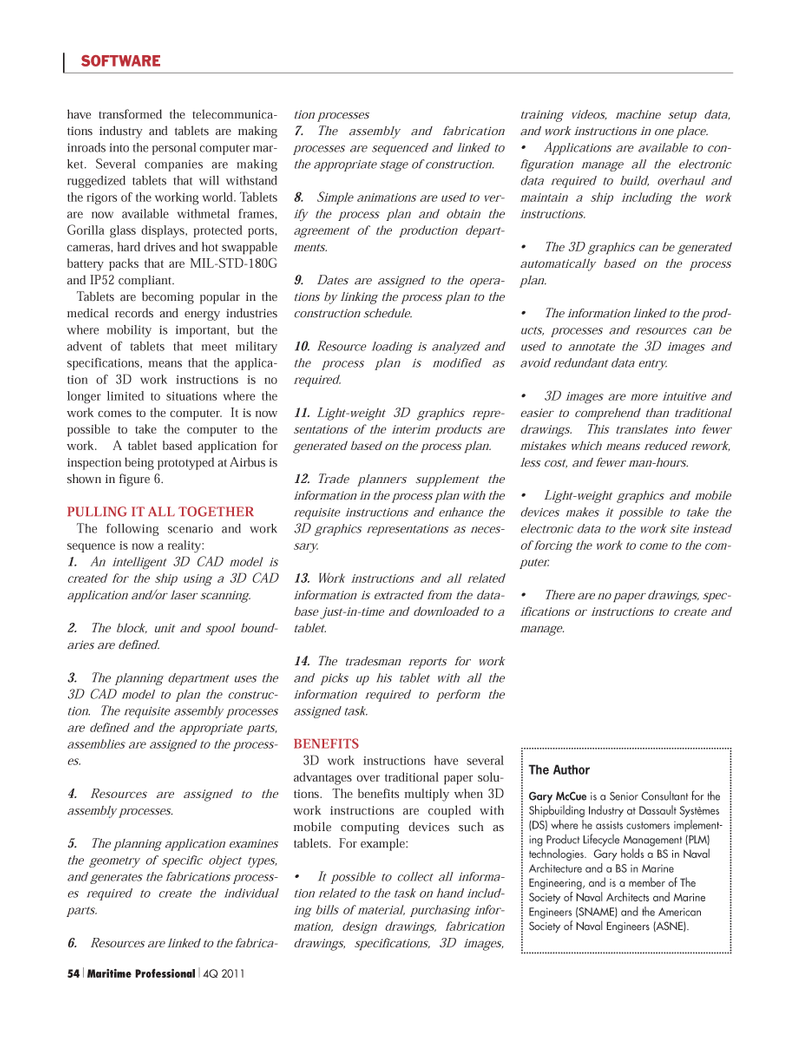
Page 54: of Maritime Logistics Professional Magazine (Q4 2011)
Classification
Read this page in Pdf, Flash or Html5 edition of Q4 2011 Maritime Logistics Professional Magazine
54 Maritime Professional 4Q 2011have transformed the telecommunica- tions industry and tablets are makinginroads into the personal computer mar-ket. Several companies are making ruggedized tablets that will withstandthe rigors of the working world. Tablets are now available withmetal frames, Gorilla glass displays, protected ports,cameras, hard drives and hot swappable battery packs that are MIL-STD-180Gand IP52 compliant.Tablets are becoming popular in the medical records and energy industries where mobility is important, but the advent of tablets that meet military specifications, means that the applica- tion of 3D work instructions is no longer limited to situations where thework comes to the computer. It is now possible to take the computer to the work. A tablet based application for inspection being prototyped at Airbus is shown in figure 6. PULLING IT ALL TOGETHER The following scenario and work sequence is now a reality:1.An intelligent 3D CAD model is created for the ship using a 3D CAD application and/or laser scanning. 2.The block, unit and spool bound- aries are defined. 3.The planning department uses the3D CAD model to plan the construc-tion. The requisite assembly processes are defined and the appropriate parts, assemblies are assigned to the process- es.4.Resources are assigned to the assembly processes. 5.The planning application examines the geometry of specific object types, and generates the fabrications process- es required to create the individual parts.6.Resources are linked to the fabrica- tion processes 7.The assembly and fabricationprocesses are sequenced and linked to the appropriate stage of construction. 8.Simple animations are used to ver- ify the process plan and obtain the agreement of the production depart- ments.9.Dates are assigned to the opera- tions by linking the process plan to the construction schedule. 10.Resource loading is analyzed and the process plan is modified as required. 11.Light-weight 3D graphics repre- sentations of the interim products are generated based on the process plan. 12.Trade planners supplement the information in the process plan with the requisite instructions and enhance the 3D graphics representations as neces- sary. 13.Work instructions and all related information is extracted from the data- base just-in-time and downloaded to atablet.14.The tradesman reports for work and picks up his tablet with all the information required to perform the assigned task.BENEFITS3D work instructions have several advantages over traditional paper solu- tions. The benefits multiply when 3D work instructions are coupled with mobile computing devices such as tablets. For example: It possible to collect all informa- tion related to the task on hand includ- ing bills of material, purchasing infor- mation, design drawings, fabrication drawings, specifications, 3D images, training videos, machine setup data, and work instructions in one place. Applications are available to con- figuration manage all the electronic data required to build, overhaul and maintain a ship including the workinstructions.The 3D graphics can be generated automatically based on the process plan.The information linked to the prod- ucts, processes and resources can be used to annotate the 3D images and avoid redundant data entry. 3D images are more intuitive and easier to comprehend than traditional drawings. This translates into fewer mistakes which means reduced rework, less cost, and fewer man-hours. Light-weight graphics and mobile devices makes it possible to take the electronic data to the work site instead of forcing the work to come to the com- puter. There are no paper drawings, spec- ifications or instructions to create and manage. The AuthorGary McCue is a Senior Consultant for theShipbuilding Industry at Dassault Systèmes (DS) where he assists customers implement-ing Product Lifecycle Management (PLM)technologies. Gary holds a BS in Naval Architecture and a BS in MarineEngineering, and is a member of TheSociety of Naval Architects and MarineEngineers (SNAME) and the AmericanSociety of Naval Engineers (ASNE).SOFTWARE MP #4 (50-64):MP Layouts 11/8/2011 2:30 PM Page 54

 53
53

 55
55
